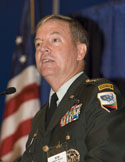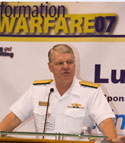U.S. Military Reaches Transformational Crossroads
 |
Lt. Gen. John R. Wood, USA, deputy commander, U.S. Joint Forces Command, opens Transformation Warfare with a presentation about the challenges to transforming during wartime. |
The U.S. Defense Department must determine and understand fully what it will take to fight in a new environment comprising both traditional and irregular warfare against an enemy with the global aspirations, will and patience to achieve its goals. The most recent conflict in
Changes in its own environment also are pushing the need to accelerate and refocus transformational efforts, the general added. If funds are reduced, the military is likely to spend what it has on traditional capabilities, and innovation and transformational concepts will suffer as the Defense Department turns inward, Gen. Wood said. This reality combined with an adversary who has adaptive fighting tactics has led to the strategic nexus the
Networks Tie Forces Together
 |
Adm. Gary Roughead, USN, commander, U.S. Fleet Forces Command, describes a number of future initiatives that will enable the |
Among the U.S. Navy’s newest endeavors is the Maritime Headquarters with
To achieve such milestones, the service needs to change its acquisition processes particularly in the area of information technology. “Computer acquisition is different than purchasing ships, so it is key that the enterprise can react and answer queries quickly and acquire capabilities faster.
Key is the open architecture approach the service is taking so it can develop, operate and maintain systems at different levels. “Don’t propose anything that’s not open architecture,” the admiral advised audience members. Specific solutions the Navy is interested in include enhancements in data throughput, data security and data compression as well as automated target recognition technologies.
Regarding information sharing, the admiral admitted that the services have suffered from inertia in the area of gathering, classifying and parsing information. “We must share information at the unclassified level and build information up to the classified level as needed. Most information sharing is stymied not by technology but by policy,” he said.
“Networks will be our battleground. Wars will be won or loss on this battleground, and we need to know if we’re ready to win or to lose,” Adm. Roughead stated.
Return to the Transformation Warfare 2007 Home Page




Comments